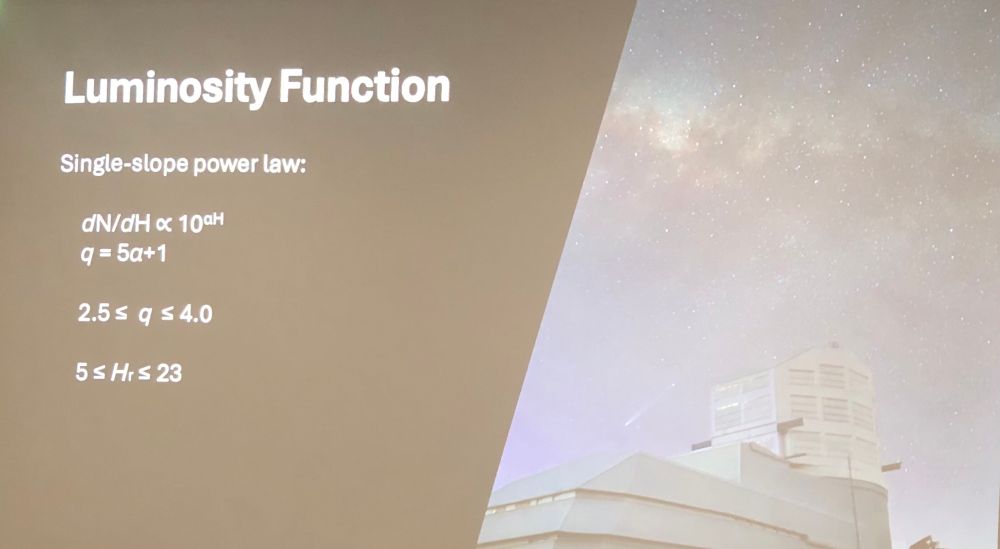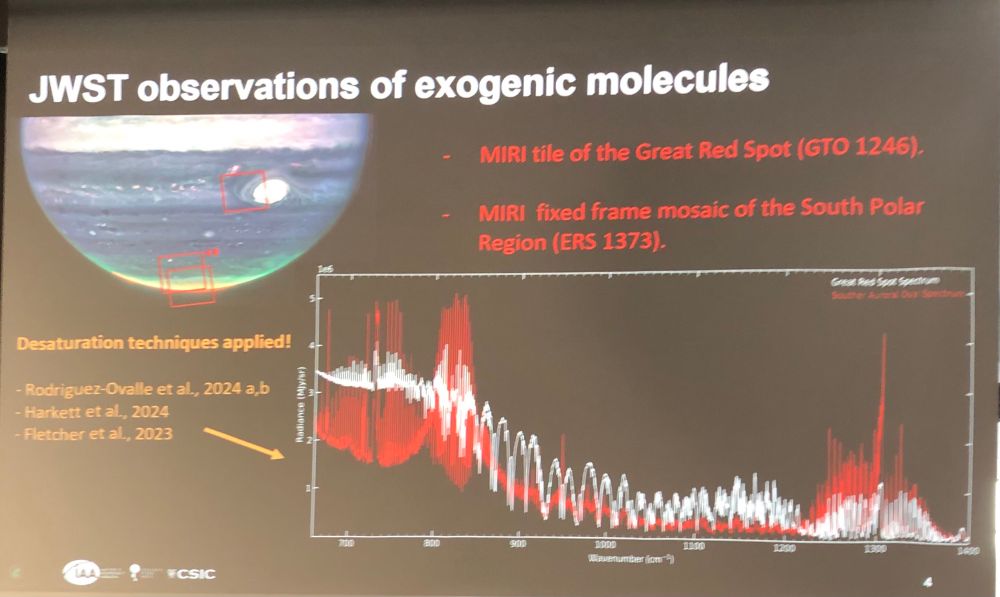
Heidi B. Hammel
@hbhammel.bsky.social
planetary astronomer | nearly famous | jwst interdisciplinary scientist | looks just like an ordinary mom | oboist (thoughts expressed here are my own)
Happy to share that the "What's Your Map?" podcast just won a Gold Award for Best Education Podcast from the British Podcast Awards 2025 - you can find a link to the podcast I participated in about celestial maps via: oculi-mundi.com/heidi-hammel

November 7, 2025 at 4:54 PM
Happy to share that the "What's Your Map?" podcast just won a Gold Award for Best Education Podcast from the British Podcast Awards 2025 - you can find a link to the podcast I participated in about celestial maps via: oculi-mundi.com/heidi-hammel
I just saw a clickbait article about how "AI helped fix JWST's blurry vision." For the record, JWST's vision is just fine! This article is talking about a quirky mode of one instrument that doesn't work well and which few astronomers use anyway. JWST is doing great - at the peak of its game!

November 5, 2025 at 3:29 PM
I just saw a clickbait article about how "AI helped fix JWST's blurry vision." For the record, JWST's vision is just fine! This article is talking about a quirky mode of one instrument that doesn't work well and which few astronomers use anyway. JWST is doing great - at the peak of its game!
Cool - these were the ones predicted by NSO's GONG network, right?

November 3, 2025 at 6:37 PM
Cool - these were the ones predicted by NSO's GONG network, right?
For my Hawai'i based friends - public talk at the @keckobservatory.bsky.social HQ in Waimea. John Grunsfeld, astronaut and Hubble repairman, will discuss "From the Hubble Space Telescope to the Habitable Worlds Observatory."

October 29, 2025 at 3:13 PM
For my Hawai'i based friends - public talk at the @keckobservatory.bsky.social HQ in Waimea. John Grunsfeld, astronaut and Hubble repairman, will discuss "From the Hubble Space Telescope to the Habitable Worlds Observatory."
Okay - NOW I understand - the "spiral" is unrelated to the comet! It is a chance superposition of a glowing trail left by a meteor in Earth's atmosphere that happened to cross the sky in the same area that the distant comet appears. This image makes this clearer. star.ucl.ac.uk/~apod/apod/a...

October 28, 2025 at 6:27 PM
Okay - NOW I understand - the "spiral" is unrelated to the comet! It is a chance superposition of a glowing trail left by a meteor in Earth's atmosphere that happened to cross the sky in the same area that the distant comet appears. This image makes this clearer. star.ucl.ac.uk/~apod/apod/a...
Doing traffic duty with my assistant (son26) for the neighborhood’s Annual Halloween Parade



October 25, 2025 at 8:18 PM
Doing traffic duty with my assistant (son26) for the neighborhood’s Annual Halloween Parade
I'll admit that Mars is not one of my favorite planets, but even I can't get enough Martian dune images from the Mars Reconnaissance Orbiter's HiRISE camera, like this one colorized to look like the planet Uranus 😉 More stunning HiRISE pix at www.uahirise.org/catalog/

September 22, 2025 at 6:20 PM
I'll admit that Mars is not one of my favorite planets, but even I can't get enough Martian dune images from the Mars Reconnaissance Orbiter's HiRISE camera, like this one colorized to look like the planet Uranus 😉 More stunning HiRISE pix at www.uahirise.org/catalog/
asteroid skymind - I am looking for a figure that shows asteroid spectral type as a function of near IR wavelength (0.9-2.5 micron) spectroscopy. Like this chart, but perhaps generalized and also with C and M type asteroids. Any leads? @asrivkin.bsky.social?

September 15, 2025 at 3:49 PM
asteroid skymind - I am looking for a figure that shows asteroid spectral type as a function of near IR wavelength (0.9-2.5 micron) spectroscopy. Like this chart, but perhaps generalized and also with C and M type asteroids. Any leads? @asrivkin.bsky.social?
Cole Gregg explores whether interstellar material might come from circumstellar debris disks (it probably can!), and if so, where that material might come from and what would be the physical characteristics thereof #epscdps #epscdps2025

September 12, 2025 at 9:26 AM
Cole Gregg explores whether interstellar material might come from circumstellar debris disks (it probably can!), and if so, where that material might come from and what would be the physical characteristics thereof #epscdps #epscdps2025
John Forbes: according to a model based on stellar populations, our galaxy contains a tapestry of streams of interstellar objects (ISOs) as illustrated in this still from a video that has been shown repeatedly in this ISO session #epscdps #epscdps2025

September 12, 2025 at 9:11 AM
John Forbes: according to a model based on stellar populations, our galaxy contains a tapestry of streams of interstellar objects (ISOs) as illustrated in this still from a video that has been shown repeatedly in this ISO session #epscdps #epscdps2025
Close encounters of the average kind: Yukon Huang explores an analytic model of interstellar objects are scattered out of their planetary systems #epscdps #epscdps2025

September 12, 2025 at 8:52 AM
Close encounters of the average kind: Yukon Huang explores an analytic model of interstellar objects are scattered out of their planetary systems #epscdps #epscdps2025
Have interstellar objects ever hit Earth? No confirmed instances based on fireball statistics but intriguing hints. Dusan Marčeta explores the possibilities with a simulation and it could happen! #epscdps #epscdps2025

September 12, 2025 at 8:38 AM
Have interstellar objects ever hit Earth? No confirmed instances based on fireball statistics but intriguing hints. Dusan Marčeta explores the possibilities with a simulation and it could happen! #epscdps #epscdps2025
Rosemary Dorsey reviews a simulation of the interstellar objects that NSF-DOE Rubin Observatory might reveal - how many, what their characteristics may be (maybe 6-51 objects - hard to detect!) @vrubinobs.bsky.social #epscdps #epscdps2025

September 12, 2025 at 8:26 AM
Rosemary Dorsey reviews a simulation of the interstellar objects that NSF-DOE Rubin Observatory might reveal - how many, what their characteristics may be (maybe 6-51 objects - hard to detect!) @vrubinobs.bsky.social #epscdps #epscdps2025
@chrislintott.bsky.social kicks off the “interstellar objects” session with an interesting discussion of how the orbits can link to potential sources of stellar populations, which gives us us context for their potential chemistry #epscdps2025 #epscdps

September 12, 2025 at 8:15 AM
@chrislintott.bsky.social kicks off the “interstellar objects” session with an interesting discussion of how the orbits can link to potential sources of stellar populations, which gives us us context for their potential chemistry #epscdps2025 #epscdps
Mike Kelley describes spectra of the icy surface of comet Hale-Bopp, taken at a distance of 46 AU (!!) with JWST 🔭 : similar to Water-type TNOs but with organic features

September 11, 2025 at 7:30 AM
Mike Kelley describes spectra of the icy surface of comet Hale-Bopp, taken at a distance of 46 AU (!!) with JWST 🔭 : similar to Water-type TNOs but with organic features
Dark filaments in Jupiter’s atmosphere in JWST 🔭 images - Arrata Antuñano shows these are very dark at 3 microns, and move very fast relative to background atmosphere, suggesting they may at be very high altitude (but not as high as the ALMA data sense). Connected to ionosphere? Io footprint?

September 11, 2025 at 6:52 AM
Dark filaments in Jupiter’s atmosphere in JWST 🔭 images - Arrata Antuñano shows these are very dark at 3 microns, and move very fast relative to background atmosphere, suggesting they may at be very high altitude (but not as high as the ALMA data sense). Connected to ionosphere? Io footprint?
Pablo Rodriguez-Ovalle discusses using JWST 🔭 to study SL9 debris (still!) on Jupiter - HCN in particular. Possible polar depletion of HNC due to heterogeneous chemistry with polar aerosols? H20 enhanced near pole, but CO2 is not - auroral chemistry? More JWST data coming!

September 11, 2025 at 6:40 AM
Pablo Rodriguez-Ovalle discusses using JWST 🔭 to study SL9 debris (still!) on Jupiter - HCN in particular. Possible polar depletion of HNC due to heterogeneous chemistry with polar aerosols? H20 enhanced near pole, but CO2 is not - auroral chemistry? More JWST data coming!
#epscdps2025 Thursday kicks off with Richard Cartwright discussing JWST 🔭 spectra of the moons of Uranus with “insanely high S/N” - rewriting our understanding of the surface chemistry of these potential ocean worlds - “CO2 absolutely everywhere” - Ariel might even be active now

September 11, 2025 at 6:12 AM
#epscdps2025 Thursday kicks off with Richard Cartwright discussing JWST 🔭 spectra of the moons of Uranus with “insanely high S/N” - rewriting our understanding of the surface chemistry of these potential ocean worlds - “CO2 absolutely everywhere” - Ariel might even be active now
Sylvia Protopapa reports on the detection of methane gas on TNO Makemake - the paper just dropped this morning! Awesome JWST 🔭 spectral resolution at 3.3 microns made the identification possible.

September 10, 2025 at 2:40 PM
Sylvia Protopapa reports on the detection of methane gas on TNO Makemake - the paper just dropped this morning! Awesome JWST 🔭 spectral resolution at 3.3 microns made the identification possible.
Not the focus of his talk, but Ian Wong featured this new paper about proposed nomenclature for trans-neptunium objects that is more oriented on composition than spectrum morphology

September 10, 2025 at 2:34 PM
Not the focus of his talk, but Ian Wong featured this new paper about proposed nomenclature for trans-neptunium objects that is more oriented on composition than spectrum morphology
Props to Josef Durech for using the asteroid Helsinki for demonstrating his phase curve work for NSF-DOE Rubin Observatory as we meet in the city Helsinki #epscdps2025 #epscdps @vrubinobs.bsky.social

September 10, 2025 at 9:14 AM
Props to Josef Durech for using the asteroid Helsinki for demonstrating his phase curve work for NSF-DOE Rubin Observatory as we meet in the city Helsinki #epscdps2025 #epscdps @vrubinobs.bsky.social
Colin Orion Chandler talks up the NSF-DOE Rubin Observatory 🔭 potential for comets, which is - of course - amazing #epscdps2025 #epscdps @vrubinobs.bsky.social

September 10, 2025 at 9:02 AM
Colin Orion Chandler talks up the NSF-DOE Rubin Observatory 🔭 potential for comets, which is - of course - amazing #epscdps2025 #epscdps @vrubinobs.bsky.social
Heads up to attendees of #epscdps2025 - there will be a splinter session about Solar System planning for the Habitable Worlds Observatory (HWO) in the Ganymede Room TODAY (Weds) at 3 pm!

September 10, 2025 at 8:34 AM
Heads up to attendees of #epscdps2025 - there will be a splinter session about Solar System planning for the Habitable Worlds Observatory (HWO) in the Ganymede Room TODAY (Weds) at 3 pm!
@megschwamb.bsky.social highlights the Sorcha model for comparison with the planned observations of Solar System objects with NSF-DOE Rubin Observatory 🔭 - Rubin will taken things to a whole new level!

September 10, 2025 at 8:27 AM
@megschwamb.bsky.social highlights the Sorcha model for comparison with the planned observations of Solar System objects with NSF-DOE Rubin Observatory 🔭 - Rubin will taken things to a whole new level!
Turning now towards another transformational telescope coming online soon: the NSF-DOE Rubin Observatory 🔭 whose HUGE field of view will vastly expand our census of small objects in the Solar System (as well not-aliens interstellar objects!) #epscdps2025

September 10, 2025 at 8:06 AM
Turning now towards another transformational telescope coming online soon: the NSF-DOE Rubin Observatory 🔭 whose HUGE field of view will vastly expand our census of small objects in the Solar System (as well not-aliens interstellar objects!) #epscdps2025

